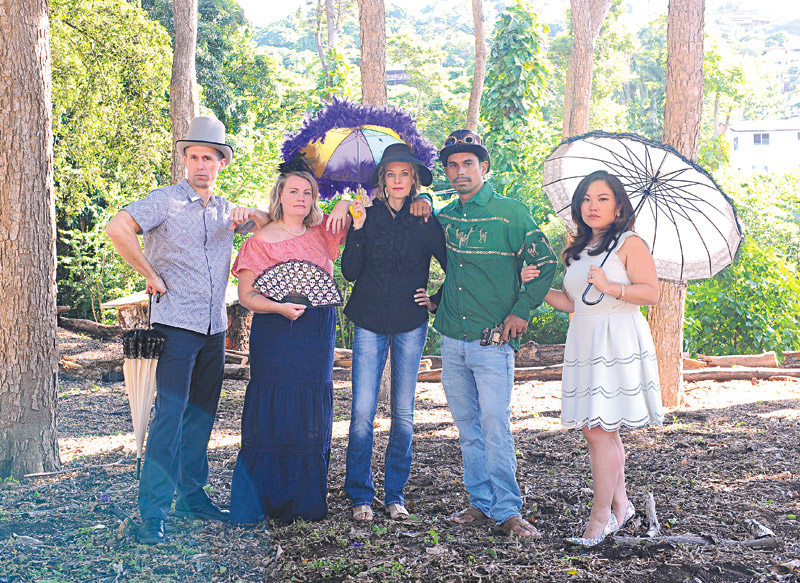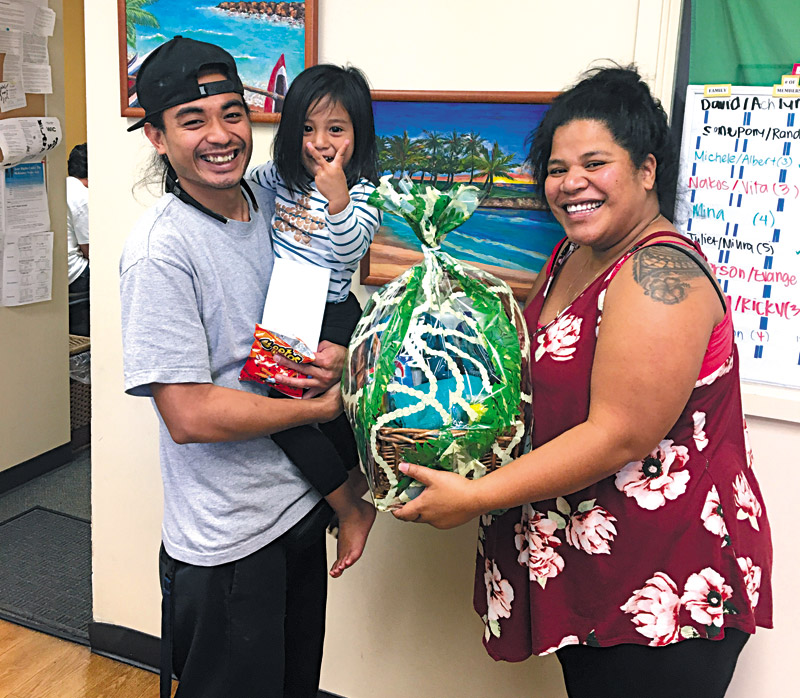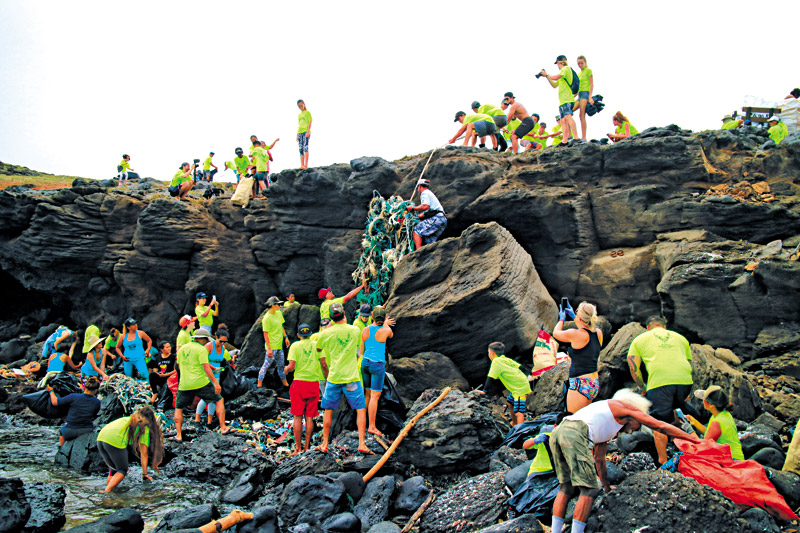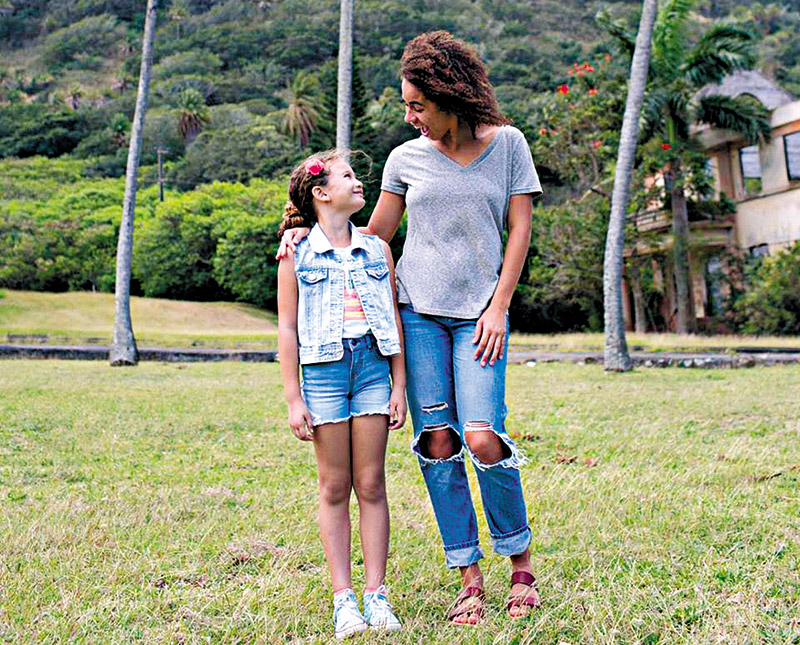The Gift That Keeps On Giving

Preparing for this year’s “Garden of GIFT and Evil” spookfest are event co-chairman Tony Mizuno, Family Promise of Hawai‘i executive director Samantha Church, Ho‘āla Nā Pua president Jessica Munoz, Sustainable Coastlines Hawai‘i executive director Kahi Pacarro, and event co-chairman Alison Tomisato Alves.
RAISING FUNDS AND AWARENESS FOR LOCAL CHARITIES IS WHAT GIFT FOUNDATION OF HAWAII HAS BEEN DOING SINCE 2004. THIS YEAR, THE PHILANTHROPIC ORGANIZATION HAS EXTENDED A HELPING HAND TO THREE GROUPS; FAMILY PROMISE OF HAWAIʻI, HOʻŌLA NĀ PUA AND SUSTAINABLE COASTLINES HAWAIʻI.
Held each October, the annual GIFT (Giving Inspiration for Tomorrow) Foundation of Hawai‘i fundraising party is a highly anticipated event. In fact, tickets usually sell out far in advance. And for the young professionals who make up the GIFT board, there’s a lot to be done: securing a venue, booking entertainment, promoting the event and creating elaborate décor.
This year was no exception. GIFT transformed The Modern Honolulu into a spooky Southern-style haunted mansion to fit the theme “Garden of GIFT and Evil” for the Oct. 13 party that attracted 600 guests for a night of live music, costumes and dancing.
But even with such a big to-do list, GIFT board member Tony Mizuno says that the most difficult part is selecting which local nonprofits they want the fundraiser to benefit.
“The hardest part of being on GIFT is that (all applicants) are really great causes,” says Mizuno, a senior executive at Bank of Hawai‘i who served as co-chairman of this year’s event alongside Alison Tomisato Alves.
GIFT was founded in 2003 as a way to raise funds and awareness for local charitable organizations while encouraging young professionals to get involved in philanthropic giving. Since its inception, GIFT has raised more than $3.25 million for more than 65 organizations throughout the state, including Waipā Foundation, Kids Hurt Too, Hawai‘i Children’s Cancer Foundation and Hawai‘i Literacy.
This year, GIFT selected Family Promise of Hawai‘i, Ho‘ōla Nā Pua and Sustainable Coastlines Hawai‘i as the recipients from a pool of more than 80 applicants.

Finding housing for families that are experiencing or are at risk of homelessness is the primary aim of Family Promise of Hawai‘i.
PHOTO COURTESY FAMILY PROMISE OF HAWAII‘I
“These three really touched our hearts,” Mizuno says.
“We are extraordinarily grateful to have the opportunity to look at organizations that benefit education, children and most of all have programs that make a direct impact on the people of the community — and these three organizations do exactly that,” says Tomisato Alves, a marketing executive at Marriott International. “Their grants will have direct impact on the people of Hawai‘i, which is something that is very important to us.”
FAMILY PROMISE OF HAWAIʻI
When Jane (name changed for privacy) was no longer able to afford rent, she and her three children were forced out of their home and onto the streets, living at a beach park.
But thanks to Family Promise of Hawai‘i, which supports families with children who are experiencing or are at risk of homelessness, Jane turned her situation around quickly.
“I received case management, learned how to save money and was able to get a job,” Jane recalls. “I received a short-term rental subsidy that allowed my family to move into our own place only 30 days after entering the shelter.”
Now, nearly a year later, Jane is still employed, and she and her children are enjoying their new home.
Stories like Jane’s are common at Family Promise. On average, the organization is able to place families into housing within 80-90 days.
“The main goal from the day that they get into the program is to get them into housing as quickly as possible,” says Family Promise of Hawai‘i executive director Samantha Church.
Family Promise is comprised of three programs: diversion, which aims to prevent people from becoming homeless; emergency shelter for overnight stays; and an aftercare program to ensure families remain in housing. The organization, which was founded in 2006 by a collective of faith-based groups that wanted to utilize their space to address homelessness, currently consists of two Family Day Centers — one in Kailua and one in Honolulu. Families can stay at the centers from 7 a.m. to 5 p.m. daily; in the evening, those in the emergency shelter program are taken to partner congregations that provide overnight care.

Volunteers with Sustainable Coastlines Hawai‘i work to keep beaches free of marine debris and litter. JEFF HAWE PHOTO
Funding from GIFT Foundation will go toward a third center in Wahiawā, which Family Promise aims to open by summer 2019. Like the two existing buildings, the new Family Day Center will feature a lounge, computer room, a well-stocked kitchen, and laundry and shower facilities. The centers also provide a range of social services that include aid in the housing search, financial literacy guidance, and job training.
“We work with them to identify what barriers they have to getting into housing and work with them on those barriers,” Church explains.
The barriers that families face, Church says, often do not fit the stereotypical image of how people may perceive homelessness. Most of the families that come to Family Promise, Church explains, “are working hard and living paycheck to paycheck, and something happens that just kind of kicks them off track.” It often involves life setbacks that can happen to anyone — perhaps they’re facing health issues, or they got laid off, or they split from their partner and no longer have two incomes.
“I always like to dispel the myth that homeless people are lazy,” she says. “Some of our families are working two or three jobs just to make it work.
“The people who we are serving are our community, they’re our neighbors, and it’s our duty to help each other survive because it is so hard to make it here.” familypromisehawaii.org
HOʻŌLA NĀ PUA
While researching child trafficking for her graduate school thesis to become a nurse practitioner, Jessica Munoz expected that her project would have an international focus. Instead, she was shocked to learn that children are bought and sold within the U.S. as well.
Munoz had already been working as a nurse and could not believe that, even as a clinical professional, she had no idea human trafficking was such a pervasive problem.
“I immediately thought about how we need to be better educating health care professionals who are probably coming into contact with these kids multiple times a day,” she recalls. “You’re never going to know to screen for it or how to recognize it if you don’t even know it’s a problem.

Ho‘ōla Nā Pua educates middle and high schoolers each year on the realities of human tra˛ cking.
PHOTO COURTESY HOʻŌLA NĀ PUA
“I was inspired that I could help educate people about the issue,” she explains. “And then I recognized that awareness is important, but it’s not enough — it’s like OK, so now what?”
That vision since has blossomed into Ho‘ōla Nā Pua, a multifaceted organization that addresses trafficking of under-age girls through four areas: health, education, advocacy and reintegration. Its work includes educating schools and other stakeholders on the issue, mentoring high-risk and victimized youths, and running a support group for families of victims. It’s also in the process of creating a long-term residential treatment facility for survivors.
The GIFT funding will bolster its range of educational initiatives, which include school presentations that reach 2,500 middle and high schoolers each year, as well as inform stakeholders how to recognize and help trafficking victims.
“The key to prevention and early intervention around exploitation is education,” says Munoz, president of the organization. “Ho‘ōla Nā Pua has worked diligently to bring education and awareness in order to prevent children from being exploited. This funding will help us continue to have a positive impact in this arena and allow us to develop enhanced educational tools to meet our desired goals for impact.” hoolanapua.org
SUSTAINABLE COSTLINES HAWAIʻI
A few years ago, Kahi Pacarro embarked on the trip of a lifetime: an 18-month journey around the world that took him to places like Bali, South Africa and the Philippines. But he noticed that everywhere he went had one thing in common: ocean pollution.
When he returned home to Kailua, he noticed that Kailua Beach was just as rife with trash and marine debris as anywhere else.
“Seeing that this issue was affecting my own home, that was the big aha moment,” Pacarro recalls. “How did I not notice that before, and if I haven’t seen this, how many other people haven’t seen this?”
As a way to provide that same sort of a-ha moment to others, Pacarro began hosting beach cleanups and launched Sustainable Coastlines Hawai‘i alongside his wife, Louise, and a few of their friends.
“The easiest way to do that is to show people firsthand,” says Pacarro, who serves as executive director of Sustainable Coastlines Hawai‘i. “You could tell people as much as you want. You could show them documentaries and pictures, but the most influential experience is actually cleaning stuff up and recognizing that this is the same stuff that you use in your everyday life. This is a result of the food you eat, or it is the broken-up pieces of stuff you consume.”
Over the years, the organization has removed about 350,000 pounds of debris, but Sustainable Coastlines realized that it needed to expand its programming in order to help prevent litter from ever reaching the shore to begin with. Today, in addition to beach cleanups, Sustainable Coastlines runs an educational program that includes school presentations, conference talks and outreach events to educate the community about recycling and reducing consumption. It also operates a waste diversion program that handles compost and recycling at events like surf contests, fundraisers and concerts.
“What keeps me going are the kids that tell me that we have changed their lives, or companies that have changed the way they do business as a result of participating in a cleanup of ours,” Pacarro says.
The GIFT funding will go toward a new educational endeavor to provide beach-cleaning excursions for students, tourists and the general public. Afterward, groups will go to a forthcoming facility to watch what they collected get recycled and turned into new products — things like phone cases, sunglass frames, or whatever else the group comes up with.
“This funding is really going to allow us to expand our reach in being able to get more kids out onto the coastlines,” Pacarro says. “It’s helping to recycle ocean plastics here in Hawai‘i and inspiring … a broader message of this entrepreneurial spirit of looking at a problem and figuring out innovative solutions.” sustainablecoastlineshawaii.org





